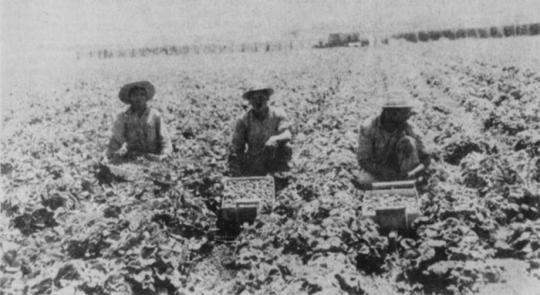The Bracero Program in Sonoma County

En Español a bracero is a day-laborer, a strong-armed man. In Western United States a bracero is a Mexican contract laborer who worked in agriculture here between 1943 and 1964, giving name to the program that was made possible by joint agreement between the governments of the U.S. and Mexico.
— LeBaron, Gaye. “Sonoma County Hispanics Recall ‘Bracero’ Days.” Santa Rosa Press Democrat, June 14, 1987.
In August 1942, the United States and Mexico signed the bilateral Mexican Farm Labor Agreement, creating an initiative now commonly referred to as the Bracero Program. It was this government-sanctioned program that first brought large numbers of Mexican workers — namely braceros, Spanish for ‘manual laborers’ or ‘farmhands’ — to harvest crops in Northern California. Launched in the wake of World War II, the Bracero Program aimed to fill labor shortages in the agricultural sector during and after the war.
Much like braceros in other parts of the United States, those that uprooted their lives in Mexico to come to Sonoma County did so with the goal of finding employment and improving their and loved ones’ lives. While the Bracero Program benefited both farmers and workers alike, the initiative also gave rise to an uneven power dynamic between growers and laborers where the latter often encountered little control over their immediate living environment and working conditions. Over its 22-year span, the Bracero Program issued nearly 4.6 million contracts until Congress ended the program in 1964. Though ended more than half a century ago, the Bracero Program has had a lasting impact on the agricultural landscape and labor standards of the Western United States — a part of the country that still to this day is largely characterized by labor disputes, worker abuses, and the sociopolitical dynamic of migrant labor.
Some of these former Braceros are foreman now, responsible for hiring workers. And they are quick to defend the ‘illegals.’ ‘They go to a farm to work!’ says one man. ‘Some of the South Americans, they tell people they are Mexicans because they know that the bosses know that Mexicans are hard-working people.’
— LeBaron, Gaye. “Farm labor has history of broken rules.” Santa Rosa Press Democrat, June 28, 1987.
Further Reading
Bracero History Archive. Roy Rosenzweig Center for History and New Media, George Mason University, Smithsonian National Museum of American History, Brown University, and the Institute of Oral History at the University of Texas El Paso.
Galarza, Ernesto. Merchants of Labor: The Mexican Bracero Story. The Rosicrucian Press, 1964.
Mitchell, Don. They Saved the Crops: Labor, Landscape, and the Struggle Over Industrial Farming in Bracero-era California. University of Georgia Press, 2012.
Torres, Alberto. Braceros in Sonoma County 1942 to 1964. Sonoma State University, 2013.

